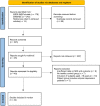White matter hyperintensities in bipolar disorder: systematic review and meta-analysis
- PMID: 38343622
- PMCID: PMC10853814
- DOI: 10.3389/fpsyt.2024.1343463
White matter hyperintensities in bipolar disorder: systematic review and meta-analysis
Abstract
Background: White matter hyperintensities are lesions of presumed vascular origin associated with Cerebral small vessel disease. WMH are common findings that and are associated with increased risk of cognitive impairment and dementia. A higher prevalence of WMH has been also reported in patients with bipolar disorder (BD), although the evidence is conflicting.
Objective: To compare the prevalence of WMH in adults with BD, with the prevalence found in healthy controls.
Methods: We searched the Embase, Medline/PubMed, and references cited in articles retrieved on May 20, 2023. We included case-control studies that compared the prevalence of WMH in adult BD patients with the prevalence of WMH in healthy controls, using T2-weighted magnetic resonance imaging. We performed a meta-analysis using a random-effects method based on the inverse-variance approach.
Findings: We included 22 case-control studies reporting data of 1313 people. The overall rate of WMH was 46.5% in BD patients and 28% in controls (pooled Odds Ratio 2.89, 95% CI 1.76; 4.75). We found a moderate heterogeneity across studies (I2 = 0.49). Publication bias was not significant.
Interpretation: We found evidence that BD patients have a higher burden of WMH than healthy controls. Main limitations were impossibility of analyzing gender differences and bipolar type, moderate heterogeneity between studies, non-representative samples, lack of control for major confounders and search in two electronic databases.
Systematic review registration: https://www.crd.york.ac.uk/prospero/display_record.php?ID=CRD42023428464.
Keywords: bipolar disorder; cerebral small vessel disease; cerebrovascular disease; microvascular disease; mood disorder; white matter hyperintensities; white matter lesions.
Copyright © 2024 Silva, Nunes, Ribeiro, Santana and Cerejeira.
Conflict of interest statement
The authors declare that the research was conducted in the absence of any commercial or financial relationships that could be construed as a potential conflict of interest.
Figures



Similar articles
-
Prevalence and incidence of stroke, white matter hyperintensities, and silent brain infarcts in patients with chronic heart failure: A systematic review, meta-analysis, and meta-regression.Front Cardiovasc Med. 2022 Sep 15;9:967197. doi: 10.3389/fcvm.2022.967197. eCollection 2022. Front Cardiovasc Med. 2022. PMID: 36186994 Free PMC article.
-
White Matter Hyperintensities and Functional Outcomes in Patients With Cerebral Hemorrhage: A Systematic Review and Meta-Analysis.Front Neurol. 2022 Mar 21;13:820012. doi: 10.3389/fneur.2022.820012. eCollection 2022. Front Neurol. 2022. PMID: 35386407 Free PMC article.
-
White Matter Hyperintensities Quantification in Healthy Adults: A Systematic Review and Meta-Analysis.J Magn Reson Imaging. 2021 Jun;53(6):1732-1743. doi: 10.1002/jmri.27479. Epub 2020 Dec 20. J Magn Reson Imaging. 2021. PMID: 33345393
-
Increased rates of white matter hyperintensities in late-onset bipolar disorder.Bipolar Disord. 2008 Nov;10(7):765-75. doi: 10.1111/j.1399-5618.2008.00621.x. Bipolar Disord. 2008. PMID: 19032708
-
Association Between White Matter Hyperintensities and Chronic Kidney Disease: A Systematic Review and Meta-Analysis.Front Med (Lausanne). 2022 May 3;9:770184. doi: 10.3389/fmed.2022.770184. eCollection 2022. Front Med (Lausanne). 2022. PMID: 35592851 Free PMC article.
Cited by
-
A Longitudinal Study of the Relationship Among Cognition, Mood Symptoms, and Markers of Brain Health in Older Age Bipolar Disorder: Une étude longitudinale de la relation entre la cognition, les symptômes thymiques, et les marqueurs de la santé du cerveau en présence de troubles bipolaires du sujet âgé.Can J Psychiatry. 2025 May 25:7067437251343295. doi: 10.1177/07067437251343295. Online ahead of print. Can J Psychiatry. 2025. PMID: 40415375 Free PMC article.
-
Outpatient Management of Bipolar Disorder in Older Adults.Curr Psychiatry Rep. 2025 Feb;27(2):77-87. doi: 10.1007/s11920-024-01576-3. Epub 2024 Dec 14. Curr Psychiatry Rep. 2025. PMID: 39672969 Review.
References
-
- De Leeuw FE, De Groot JC, Achten E, Oudkerk M, Ramos LM, Heijboer R, et al. . Prevalence of cerebral white matter lesions in elderly people: A population based magnetic resonance imaging study: The Rotterdam Scan Study. J Neurol Neurosurg Psychiatry (2001) 70(1):2–3. doi: 10.1136/jnnp.70.1.2 - DOI - PMC - PubMed
Publication types
LinkOut - more resources
Full Text Sources

